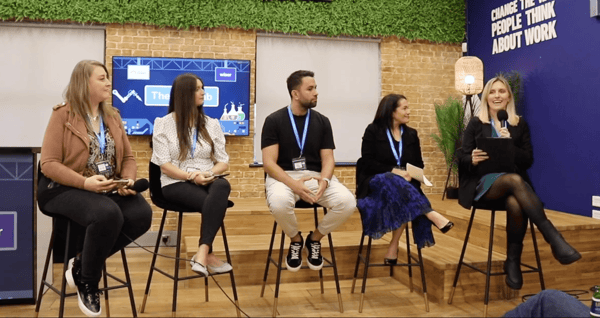You don’t need me to tell you there are loads of factors that contribute to a good Employee Value Proposition (EVP), including job progression, recognition, benefits, reward and wellbeing. And since the pandemic, there’s been a noticeable shift in what employees want from their employers. And, to make it just a little bit more complicated, that seems to differ across every generation.
Our recent research has shown that 56% of Gen Z employees frequently experience burnout, compared to only 29% of baby boomers. Almost half of the younger generation perceive financial, mental and physical wellbeing support as a must-have from an employer, in contrast to only 27% of baby boomers. So how do we adapt in the long and short term? How do we stay relevant across multiple generations?
 Recently, I had the honour of moderating a panel with some absolute Reward superstars: Nebel Crowhurst, Chief People Officer at Reward Gateway; Christina McGraw, Reward Lead for UK&I McDonald’s; Alex Ayin, Marketing Director at Wiser; and Debra Corey, Chief Pay it Forward Officer at DebCo HR Ltd and published author. Together, they shared insights answering the questions I posed above, and I learned some great ideas that I’m eager to share with you.
Recently, I had the honour of moderating a panel with some absolute Reward superstars: Nebel Crowhurst, Chief People Officer at Reward Gateway; Christina McGraw, Reward Lead for UK&I McDonald’s; Alex Ayin, Marketing Director at Wiser; and Debra Corey, Chief Pay it Forward Officer at DebCo HR Ltd and published author. Together, they shared insights answering the questions I posed above, and I learned some great ideas that I’m eager to share with you.
Pinpointing the pandemic’s effect on total rewards strategy
COVID-19 undeniably changed both the way we think about work and the way we think about our roles within an organisation. There’s been an increasing demand for wellbeing support from employers, for example, and the adoption of flexible work arrangements is becoming a must-have.
 “As employees’ expectations grew – and continue to grow – around what they want [and need] from us as employers, we need to become smarter with what our wellbeing strategies look like,” Nebel said. “How do we support people with their mental health, their emotional health, their financial wellbeing? And what are the things that we need to put in place to make sure that we’re doing everything we can to meet all those different expectations? And… from a generational perspective, what are the differing needs for different people at different stages of their lives, and how do we provide what they need at this point?”
“As employees’ expectations grew – and continue to grow – around what they want [and need] from us as employers, we need to become smarter with what our wellbeing strategies look like,” Nebel said. “How do we support people with their mental health, their emotional health, their financial wellbeing? And what are the things that we need to put in place to make sure that we’re doing everything we can to meet all those different expectations? And… from a generational perspective, what are the differing needs for different people at different stages of their lives, and how do we provide what they need at this point?”
Employee and consumer trust hit a rocky road throughout the pandemic as well, and trust can be hard to find and build before a looming recession, but it’s critical that employers hyperfocus on the experience they provide their employees to engage them in and outside of working hours.
“People buy into people,” Alex said. “They believe the stories of people. You’ll have amazing stories from across the organisation – give people the tools to be able to tell [those stories]. 85% of people will trust another person's or colleague’s recommendation [versus] only 50% from the brand channel. The more you can mobilise your people and overcome some of those objections that people might think in that recruitment process, the better we’re seeing in terms of conversion rates of applications.”
Don’t just build your EVP, package and promote it!
It’s not enough to put all your work into establishing your EVP – you have to ensure that it becomes embedded in company processes and culture, and that employees have the access to the information they need to discover what’s available to them.
 Especially since the pandemic, we’ve seen a lot of employers trying to raise pay to stay competitive, but real pay is only a fraction of the total EVP, and, realistically, sometimes isn’t an option when other priorities are more important. But, at an enterprise scale, we know that introducing new benefits is not only time-consuming, but costly, and hard to get over the line when you've got multiple stakeholders involved.
Especially since the pandemic, we’ve seen a lot of employers trying to raise pay to stay competitive, but real pay is only a fraction of the total EVP, and, realistically, sometimes isn’t an option when other priorities are more important. But, at an enterprise scale, we know that introducing new benefits is not only time-consuming, but costly, and hard to get over the line when you've got multiple stakeholders involved.
Our research has also shown that 45% of Gen Z employees think that a holistic approach to benefits is actually more important than pay.
“All of us can say we have huge consumer budgets to understand what our consumers [and customers] want – but do we really put the same amount of energy from a people perspective?” Christina asked. “So, first of all, find out what your people want. Then, just understand how that aligns everything around the EVP… Be comfortable with how you want [your benefits package] to look, own it and then set it. Do it the same way you market products.”
Technology’s role in EVP
Younger generations of workers, those ‘internet natives’ who are accustomed to rapidly evolving technology and increasingly seamless consumer experience aren’t the only impatient workers. We all have smartphones, Nebel pointed out, and we all go a little nuts if we can’t get an answer straight away.
“We’ve got to work fast to be able to make a difference in the speed and the pace in which we can provide information and answers,” Nebel said. “One of the things we introduced [at a] global pharma company a few years ago was a new knowledgebase platform that enabled people to self-serve the HR answers that they needed quickly. And it made a huge difference, because not only were people able to feel a bit more empowered to get the information, deal with the situation and move on, it also then meant – from a team point of view – our people team were focussing on much more impactful strategic work, rather than the sort of day-to-day transactional stuff.”
Have an age-diverse workforce and hungry for more dynamic EVP tips? Check out this next blog to learn about the impact of values, branding and recognition.
Looking for more insights to help take your employee experience to new heights? Schedule a call with a member of our Engagement team.

 Charlotte Neal
Charlotte Neal
